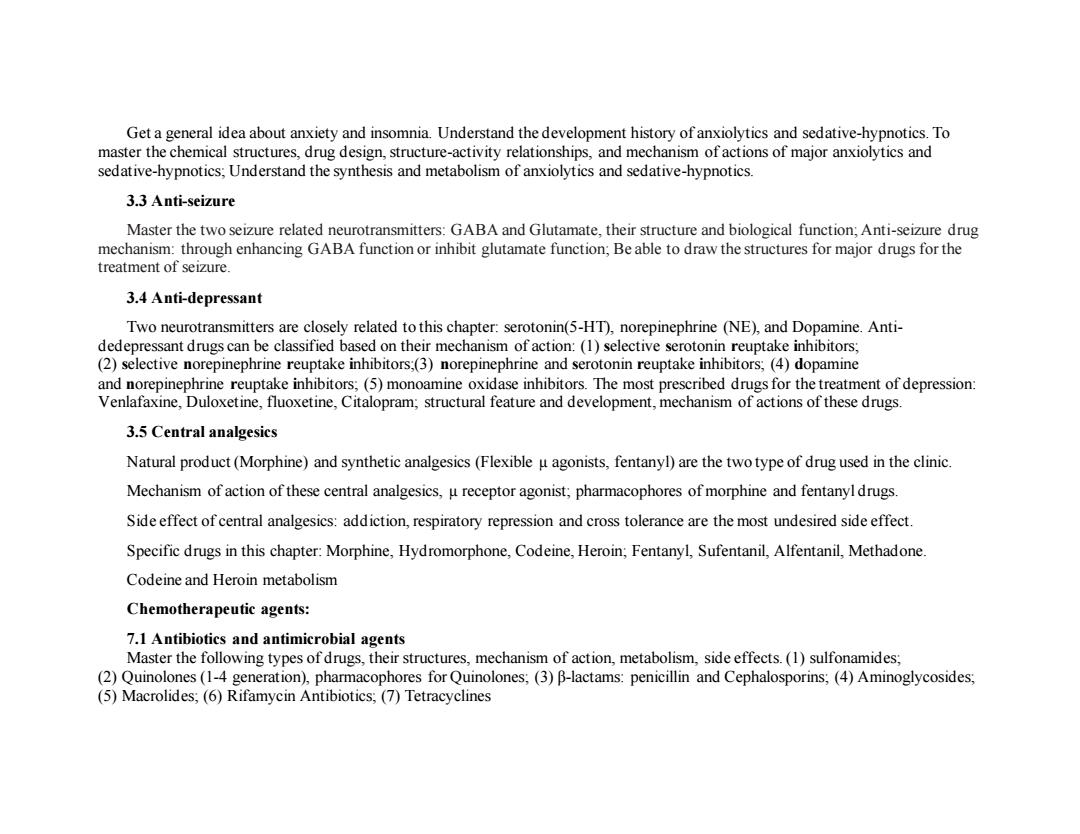正在加载图片...

Get a general idea about anxiety and insomnia.Understand the development history of anxiolytics and sedative-hypnotics.To master the chemical structures,drug design,structure-activity relationships,and mechanism of actions of major anxiolytics and sedative-hypnotics;Understand the synthesis and metabolism of anxiolytics and sedative-hypnotics. 3.3 Anti-seizure Master the two seizure related neurotransmitters:GABA and Glutamate,their structure and biological function;Anti-seizure drug mechanism:through enhancing GABA function or inhibit glutamate function;Be able to draw the structures for major drugs for the treatment of seizure 3.4 Anti-depressant Two neurotransmitters are closely related to this chapter:serotonin(5-HT),norepinephrine (NE),and Dopamine.Anti- dedepressant drugs can be classified based on their mechanism of action:(1)selective serotonin reuptake inhibitors: (2)selective norepinephrine reuptake inhibitors;(3)norepinephrine and serotonin reuptake inhibitors;(4)dopamine and norepinephrine reuptake inhibitors;(5)monoamine oxidase inhibitors.The most prescribed drugs for the treatment of depression: Venlafaxine,Duloxetine,fluoxetine,Citalopram;structural feature and development,mechanism of actions of these drugs. 3.5 Central analgesics Natural product(Morphine)and synthetic analgesics(Flexible u agonists,fentanyl)are the two type of drug used in the clinic. Mechanism of action of these central analgesics,u receptor agonist;pharmacophores of morphine and fentanyl drugs Side effect of central analgesics:addiction,respiratory repression and cross tolerance are the most undesired side effect. Specific drugs in this chapter:Morphine,Hydromorphone,Codeine,Heroin;Fentanyl,Sufentanil,Alfentanil,Methadone. Codeine and Heroin metabolism Chemotherapeutic agents: 7.1 Antibiotics and antimicrobial agents Master the following types ofdrugs,their structures,mechanism of action,metabolism,side effects.(1)sulfonamides; (2)Quinolones(1-4 generation),pharmacophores for Quinolones;(3)B-lactams:penicillin and Cephalosporins;(4)Aminoglycosides; (5)Macrolides;(6)Rifamycin Antibiotics;(7)TetracyclinesGet a general idea about anxiety and insomnia. Understand the development history of anxiolytics and sedative-hypnotics. To master the chemical structures, drug design, structure-activity relationships, and mechanism of actions of major anxiolytics and sedative-hypnotics; Understand the synthesis and metabolism of anxiolytics and sedative-hypnotics. 3.3 Anti-seizure Master the two seizure related neurotransmitters: GABA and Glutamate, their structure and biological function; Anti-seizure drug mechanism: through enhancing GABA function or inhibit glutamate function; Be able to draw the structures for major drugs for the treatment of seizure. 3.4 Anti-depressant Two neurotransmitters are closely related to this chapter: serotonin(5-HT), norepinephrine (NE), and Dopamine. Antidedepressant drugs can be classified based on their mechanism of action: (1) selective serotonin reuptake inhibitors; (2) selective norepinephrine reuptake inhibitors;(3) norepinephrine and serotonin reuptake inhibitors; (4) dopamine and norepinephrine reuptake inhibitors; (5) monoamine oxidase inhibitors. The most prescribed drugs for the treatment of depression: Venlafaxine, Duloxetine, fluoxetine, Citalopram; structural feature and development, mechanism of actions of these drugs. 3.5 Central analgesics Natural product (Morphine) and synthetic analgesics (Flexible µ agonists, fentanyl) are the two type of drug used in the clinic. Mechanism of action of these central analgesics, µ receptor agonist; pharmacophores of morphine and fentanyl drugs. Side effect of central analgesics: addiction, respiratory repression and cross tolerance are the most undesired side effect. Specific drugs in this chapter: Morphine, Hydromorphone, Codeine, Heroin; Fentanyl, Sufentanil, Alfentanil, Methadone. Codeine and Heroin metabolism Chemotherapeutic agents: 7.1 Antibiotics and antimicrobial agents Master the following types of drugs, their structures, mechanism of action, metabolism, side effects. (1) sulfonamides; (2) Quinolones (1-4 generation), pharmacophores for Quinolones; (3) β-lactams: penicillin and Cephalosporins; (4) Aminoglycosides; (5) Macrolides; (6) Rifamycin Antibiotics; (7) Tetracyclines